| The campsite at Morgan City has a number of trees which are
festooned with Spanish moss. This used to be collected as a crop and
was used to stuff mattresses and furniture and also to make a sort of
plaster the original Acadians used in building their houses, before the development of foam
rubber. | 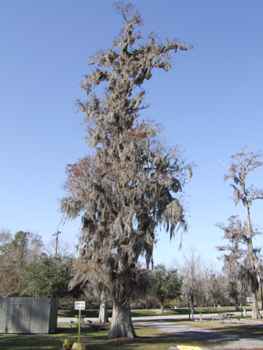 |
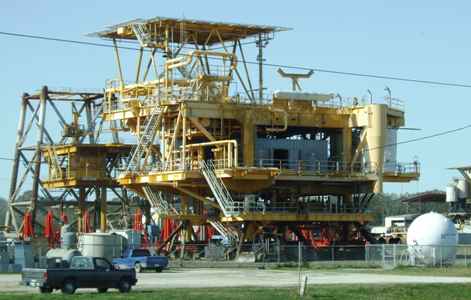 | The Morgan
City area is the base for most of the offshore oil industry in the Gulf off
the shores of Louisiana. This includes a fairly thriving specialist
shipbuilding industry which builds oil production and control platforms. The
helicopter landing platform on this one is right at the top. |
| The other bank of the river has a business building rafts one of
which had a drill rig on it. These would be used in shallow waters such as
close inshore along this coast. | 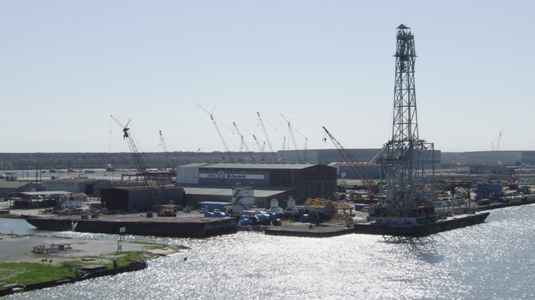 |
We stopped in at another part of the Jean Lafitte park where there are yet
more artifacts from Acadian history. Here we have the traditional accordian
and a triangle. In the early days they could not afford violins so they used
home made ones made from cigar boxes.
| As we came closer to the Mississippi river we came to the
region of the sugar plantations where many of the big houses were built 'antebellum',
ie before the Civil War. Many of
these are now open to the public, with guided tours available. We came to three
virtually next door to one another, at Vacherie.
This is the Felicity estate mansion hiding amongst the oak trees. It was built
c1850. | 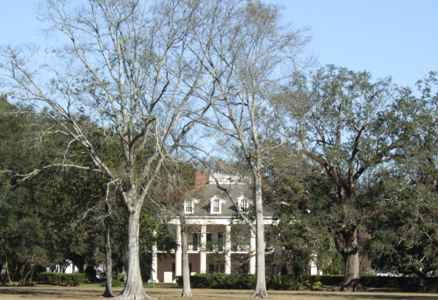 |
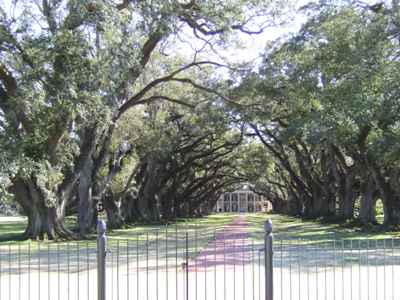 |
The third one was Oak Alley.
The estate was founded about 1718 and named for the 28 300
year old oak trees which line the driveway to the original house. The current house
was built 1837-9. |
| We visited the one in the middle,
St Josephs,
whose family married into the Felicity estate in 1899. The
house looks much grander than it really is. The plantation has a river
frontage about a mile wide and seven miles
deep away from the river. The Mississippi River was really important as a
means of communication and transport for the sugar cane and other supplies. The
current owners are now trying to restore the house. It
was originally built c1820 in a
raised Creole style that predates nearby plantations constructed in Greek
revival style. The home stands on brick columns 8 feet tall so that when the
river flooded the house was protected, and goods stored on the ground floor
were moved to safety. | 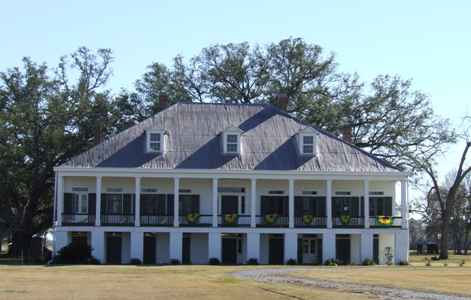 |
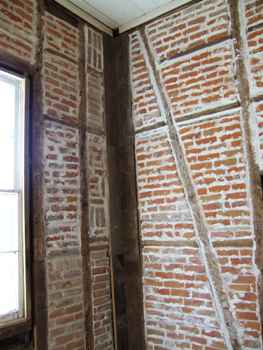 | One of the
rooms had the plaster removed which showed the wooden post construction with
locally made brick infill. |
| The house had been emptied of furniture by the family over the
years, so they are gradually acquiring some of the original pieces and other pieces of the
period. There are several piano-type instruments. The
paintings are of various family members. We were taken round (on a personal
tour) by a member of the family which has owned the property for the last
130 years. This represented the cream of the local society with governors
and local sugar magnates including those who developed the process of
granulating sugar. It was also the birthplace of H. H. Richardson, a member
of the family and one of
America's most important architects of the 19th century. | 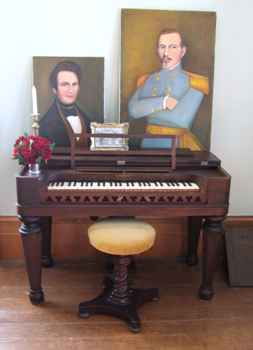 |
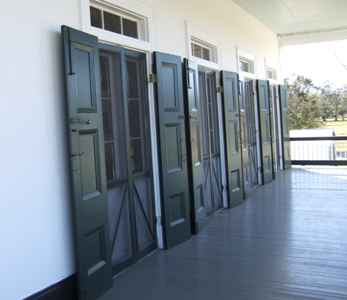 | There are
doors between all of the rooms, and these are in line with windows at each
end of the house, so when it was really hot in the summer they would all be left open to provide a
through draught. The wide verandahs at the front and the back keeps the sun
from shining directly into the rooms. Each room also has a door like these
opening on to the verandahs. Each of these doors has an inside door, an outside shutter
and a screen door in between. There are over 150 doors in this house. |
| The women of the family were all renowned as cooks and
entertainment was a common feature of their lives. Even today members of the
family are active winemakers and growers and theawere said to be quite
good. | 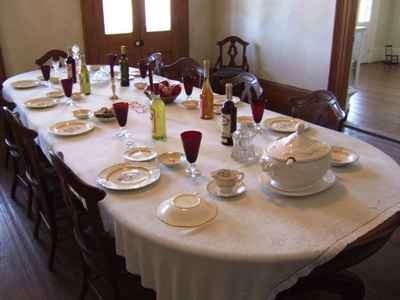 |
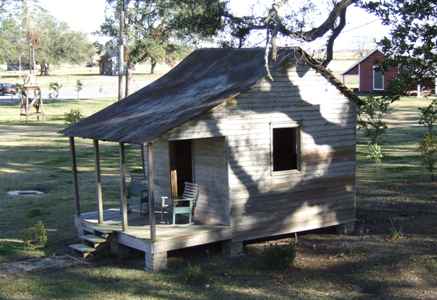 | There are a
number of additional buildings close to the main house. Some were used as
the kitchen, others as homes for minor family members and overseers. This
was used as a corn store at one time. The slave quarters were a little
further away from the house. |
| With the heat and lack of rain there was a real danger of fire,
so the kitchen was in a separate hut to one side, and of course the cooking
would originally have been done by slaves or servants. The 'kitchen' is now quite empty but even in these 'grand' houses
of the area, life would have been less advanced than in the east coast
cities. | 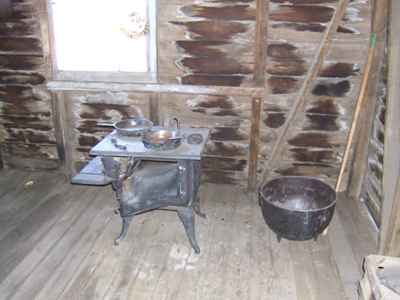 |
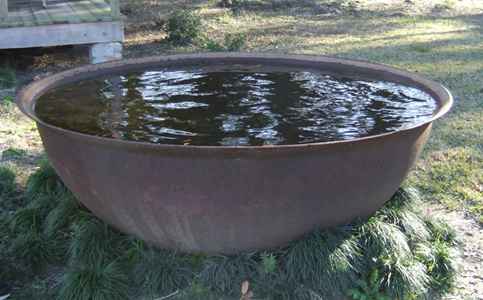 | Before factory
processing and granulation was developed, local sugar production would have
been done by boiling the cane syrup in these large bowls. This is a small one and
is only about 10 ft in diameter. |
| They do have a document from 1858 showing the valuation of the
estate at that time. This is a transcription of just a small part of it but you can see that
the slaves were actually regarded as being quite valuable. | 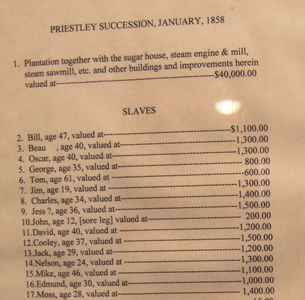 |
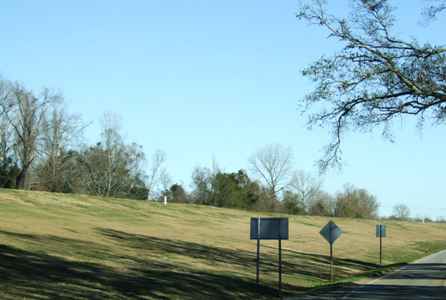 | The houses all face the Mississippi levee. This would not have
been so high when the houses were built and they would have been able to see
the river and their landing stage from their balcony. The lower floor would
not have been used as accommodation because of the regular flooding. The levees were raised
in the mid 1900s after the disastrous 1927 floods. |
| There is still
a huge amount of barge traffic on the Mississippi. These are just moored
waiting for a pusher tug to move them to where they are needed. |  |
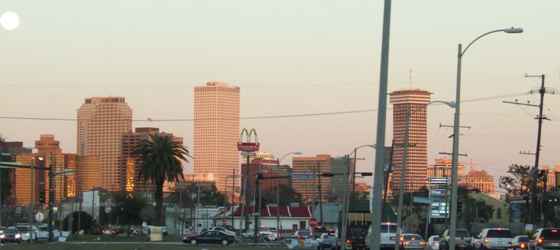 | And so in the late afternoon we approached New Orleans. We saw
little damage on the western approaches and it just looked like any other
fairly scruffy city. The hurricane damage became more apparent later. |
We were very fortunate to find any campsite in New Orleans and that became
apparent as we arrived. This site was 5 ft under water at the height of the
floods. For the moment we just watched the sunset. |